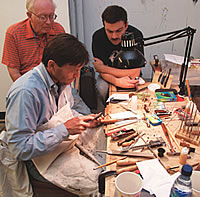 |
 |
 |
||||
 |
|
 |
|
 |
|
Trading Trade Secrets “We’re all competitors,” says fiddler-turned-bow maker Lee Guthrie, a smile creeping across his face. Like the other professional bow makers at the VSA/Oberlin Bow Makers Workshop, Guthrie, from St. Paul, Minnesota, had spent the past three weeks fashioning pieces of wood into tightly drawn rods. Because bow makers compete for a relatively small market, one might expect these craftspeople to keep their techniques close to the vest. But sharing trade secrets is the essence of this summer workshop. As the bow makers work intently in a basement studio of the Allen Art Building, an easy chatter fills the space. People shuffle comfortably from table to table, exchanging tips and techniques to take back to their own workstations.
Down the hall, where the VSA/Oberlin Violin Makers Workshop is taking place, the scene is much the same. Cultural accents blend as visiting violin makers painstakingly draw harmonic proportions derived from the Classics, a nearly forgotten technique that is taught enthusiastically by renowned violin maker François Denis. The bow-making and violin-making workshops, directed respectively by David Forbes and Christopher Germain, are “the greatest social events of the year,” says bow maker Guthrie. Co-sponsored by Oberlin College and the Violin Society of America (VSA), the concurrent workshops place makers of violins and bows in an uninhibited environment where secrets, varnishes, techniques, and handmade planes passed down by mentors are shared equally among the experienced and those new to the business. The summer workshops evolved from the old Oberlin Stringed Instrument Restoration Workshop, a summer program begun 17 years ago by the late master restorer Vahakn Nigogosian. When he died, the focus of the program changed from restoration to violin and bow making. While in Oberlin, the participants stay in Keep Cottage, where friendships are deepened through shared meals, group sing-a-longs, and, of course, violin playing. Both workshops begin with a group project, the creation of a bow and violin; profits from their sale help bring experts from around the world to the workshops. In the bow-making class, master bow maker Jean Grunberger discusses his craft: “Wood selection makes good bows, and they must have balance.” The 29-year veteran has traveled from France to attend the class each summer since the workshop began. His impressive clientele, year-long waiting list, and willingness to share his techniques make him a favorite among peers. “Many American bow makers fashion their bows so that the bend lines up with the frog. French makers simply move the frog,” he says. (Also called the nut, the frog is the lower part of the violin bow.) Hearing this gem of bow-making wisdom, Sue Lipkins glances up from her work. A resident of Woodstock, New York, she is the only bass bow maker in the group. “I wanted to be a bass player and was offered a job at a bow-making shop,” Lipkins says. “I started out there as a salesperson and got into making bows.” This is her fifth Oberlin workshop. “There are people here from France, Italy, Germany, England, Norway, Canada, and Belgium,” whispers Germain, the violin workshop director, while luthiers in the violin makers’ studio erase and sketch freehand patterns. “We all have insight and expertise, which raises the standard for the class,” he says. “Violin and bow makers typically work alone, closed off from each other. This workshop allows them to see what their peers are doing, and which new techniques have been developed. It’s good.” “There’s never an end to what you can learn here,” Guthrie adds. Next Page >> |
